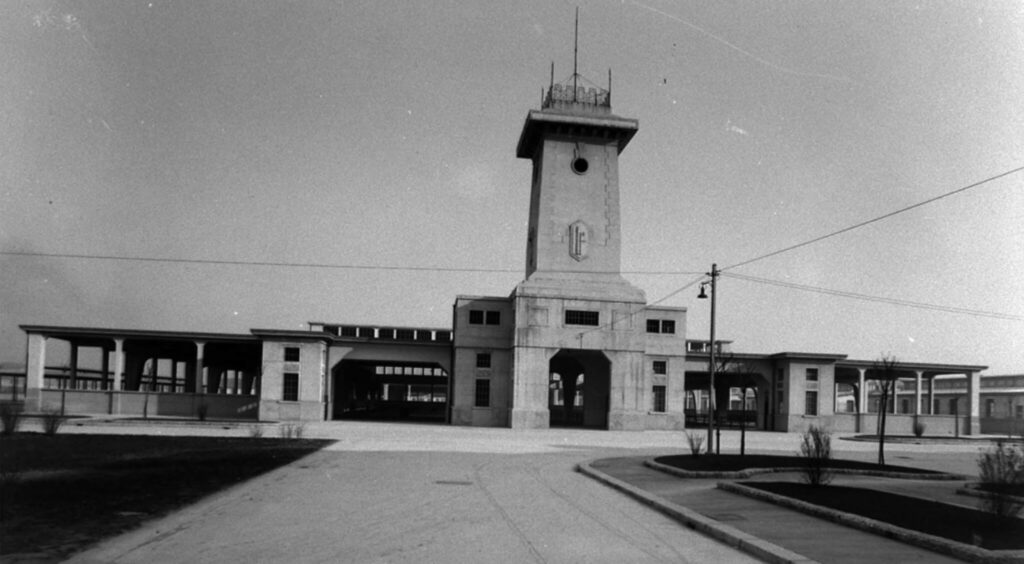“In this way we have all become artisan-artists, furnished with super-instruments for doing what we feel like by ourselves. We are also nomad-artists (or even not nomads), in that we are freed from the factory, the bureau, the supermarket, the bank, the street, the pavement, the tube […]”
—Ettore Sottsass Jr., “The Planet as a Festival,” Casabella #365, 1972
When we were sent the link to the article “Alcova, a temporary design exhibition in Milan, takes place within a wider context of real estate speculation,” by Andrea Bagnato, we opened it with genuine interest and curiosity. Alcova, the temporary exhibition platform we founded together in 2018 which is nominally the subject of the article, reached its fifth edition this year. It is fair to say that from modest roots, Alcova has evolved into something of a phenomenon, with queues forming outside the gates well before opening time, an influx of visitors surpassed only by the main design fair itself, and an almost obsessive media interest, ranging from Italian national TV channels to the Financial Times to the neighborhood zine. While this somewhat unanticipated appreciation is rewarding, the question of what this phenomenal success means for the project—and what it means for the city—was already at the forefront of our minds. We welcomed this timely opportunity for a constructive reflection on how the energies generated by this platform could most usefully be channeled in the future, both for the good of the city and the broader good of design as a discipline. While its sentiments are noble, we find the article problematic in that it confuses causation with correlation, and as a consequence winds up doing little more than patronizing the citizens of Milan.
It is useful to begin with why we started Alcova in the first place. As is well known, Milan is home to the Salone del Mobile, indisputably the world’s most important design fair, with an expected 327,000 visitors this year to the main fair. (For proportion, this is approximately three times the attendance numbers of other successful design fairs such as Paris’s Maison & Objet). Yet despite its colossal scale and commercial success, or perhaps precisely because of these, around 2016 we felt that the spectrum of the work presented in Milan, particularly in the Fuorisalone, was shrinking. Speaking to our friends and colleagues, we could see that the research, experimentation, and risk-taking that had characterized the Fuorisalone in its earlier years was less present in recent versions. In some cases, commercial interests (originating both within the design industry and outside it) had gradually displaced what we found most valuable—the new graduates, independent designers, design schools, collectives, associations and nonprofits whose work propelled collective thinking about design beyond the accepted boundaries.
Equally importantly, we observed that the visitor-oriented, one-week event did not engage Milan’s inhabitants. The majority of events took little interest in the community; and needless to say, this sentiment was squarely reciprocated by the community itself, which steered well clear of anything related to the Design Week. Ironically, one of the few organizations which shared this preoccupation was the cultural institution Macao, whose demise the article obliquely connects to the arrival of Alcova and with which—as Bagnato’s text neglects to mention—we collaborated with back in 2016 to create an independent, open, and democratic design exhibition.
It was from this dream of a richer and more meaningful Fuorisalone that Alcova was born. But it also came from an attempt to find a more mature approach to the question of how to harness the formidable forces at play, balancing the greater good of the design field—one of the most important for the Milanese and Italian economies, and arguably the future of the world in general—and the interest of the city’s communities. In particular, Alcova sought to propose an alternative paradigm to the “design district” model, pioneered with unfortunate consequences by the Lambrate neighborhood. There, a decade-long process of inevitable (corporate) infiltration of what started as an independent design platform led to a spectacularly drugged real estate market, permanent displacement of the local community, and ultimately the implosion of the event itself which could no longer afford to pay the rents it had contributed to distort.
What we envisioned was what we missed in the Fuorisalone: a platform for free-thinking critical exchange in which people and ideas came first. We understood that in order to remain viable, we would need to be itinerant to escape from speculative exploitation by rent-seeking landlords. But in this proposition of itinerancy, we glimpsed another possibility, that of a platform that could truly engage with the city, its citizenship and its communities, which would unlock the doors to places in which the fabric of its identity was woven and the history of its form was written. Our intuition was that a formula existed in which an independent platform for design could also become a promoter of a deeper knowledge and awareness of the city by the community itself and that these two goals could in fact be a multiplier of one another.
Last Wednesday, we went for a walk around the Ex Macello, the current site of Alcova, and through the surrounding neighborhood. Just around the corner is Il Nuovo Macello, a family-run restaurant which has been continuously active under the management of the same family since the 1960s. Paola, the proprietor, spoke to us of her emotion at stepping through the gates of the slaughterhouse, which she had not entered since she was in 14. As well as visiting the exhibition, she admitted to having ducked through the barriers to catch a glimpse of the building adjacent to the one formerly occupied by Macao where she grew up playing with a friend, also named Paola, the daughter of one of the refrigeration technicians who worked in the slaughterhouse. Inside Alcova, we spoke to Franco and Laura, a couple in their eighties who lived their entire lives in the neighborhood without entering the complex, incredulous at the decadent beauty of the cathedral-like space of the site’s main artery. Giuseppe, a regular at the Bon Ton Cafe opposite, could recall when, 30 years ago, an accidental corrida took place on Viale Lombroso after a bull escaped from its pen. The fact that this was his first and last chance to salute this site in its current state before his neighborhood entered a new era was not lost on him.
Most, and the article’s author presumably among them, would agree that there is merit in offering citizens like these access to their own city. The debate appears to be around who has the right to engage in a project of this kind, which sets out to bring an exhibition to people and people to their city, and in what context, given the broader important argument currently raging in the Italian media around Milan’s (un)affordability.
Bagnato’s thesis that Alcova is an instrument of gentrification hinges on the roles he assigns to the various actors. This is where the specifics of his argument, and their accuracy, become important. In order to paint Alcova as an opportunistic, naive, and morally unmoored agent of urban transformation, he needs a villain, which in this case is the winner of the redevelopment competition, an entity he names as “Redo sgr, a real-estate fund controlled by Italian banks.” This characterisation is inaccurate: The primary investor in this specific project is in fact Fondo Immobiliare Lombardia, which defines itself as the first real estate fund with an ethical mandate in Lombardy region; its primary source of funding is the Italian state. Its mother company, Redo sgr, is a B-corp with a mandate to build affordable housing, and its majority stakeholder is a philanthropic foundation funded by banks. Among the many future uses Bagnato lists for the site, he omits to mention that the main one is housing, among which 1,200 units classed as edilizia residenziale sociale (social housing) to be rented at a subsidized rate of about $650 (€600) for an apartment of 750 square feet (70 square meters). What utility Alcova’s “veneer of coolness” possesses for one of the less speculative developments in a city on fire with speculation—and in urgent need of housing—is left unclear. One is left with the feeling that, lacking the means to meaningfully engage with a development project he dislikes, the author takes aim at an easier target: a popular, highly visible, independent urban initiative with a staff of five.
The tendentious nature of the argument does not end there. The site of the last two editions of Alcova, a military hospital that had never before been open to the public (where generations of Milanese did their “tre giorni” three-day health checkup before compulsory military service), is one of the most beautiful and least-known urban parks in the city. Never before accessible to the public, it belongs to the Demanio, the property ownership body of the Italian state, and is literally off limits for development. Opening it required months of hard work and complex negotiations. It is not easy to forget the hundreds of people who expressed gratitude to Alcova for making visible, albeit temporarily, such a notable location in the history of the city or those who were moved by the recollections triggered by the return to the site of a teenage rite of passage. And it is hard to imagine that anyone can sincerely believe that opening the gates to this unknown treasure for a total of 14 days over the span of two years amounts to “greasing the wheels of development” in a neighborhood which had not been the object of any cultural activity of any kind before or since.
Likewise, as regards Alcova’s first site, a historic panettone factory with exquisite Rationalist elements, the author omits to explain that the redevelopment that followed was not a consequence but the cause for Alcova’s presence there, as a last-ditch attempt to attract attention to this unique site and find an alternative to its otherwise inevitable demolition. We ultimately failed to save it but not for lack of trying.
So if none of these venues are acceptable settings for a project like Alcova, what is? As so often happens in the context of debates around the future of the urban realm, this conversation quickly becomes a tug of war between those privileged enough to be able to assume positions of uncompromising idealism and those who take the risk of getting their hands dirty—and possibly making mistakes—in the name of actually building the city they wish to inhabit. This tension, and the debate it produces, can be a productive one. But it also requires rigor and the willingness to listen to those outside one’s own bubble. However earnest one’s sentiments and political convictions might be, a privileged, distanced vantage point can make for misleading readings of the urban landscape and the true aspirations of its inhabitants. One risks becoming an unwitting agent of a pernicious, elitist conservatism that denies the right to the city simply because its fabric is judged to not be sufficiently pure to be experienced by its own citizens.
Alcova’s wild and unexpected resonance with a broad audience inside and outside the design community should make us reflect on what we can and should expect from our cultural institutions. We remain open, as we have been since the beginning, to a constructive debate around the role we can play for Milan. At a time when architects and cities are finally questioning the act of building as the default solution to programmatic needs, there is an opportunity to be more creative and inventive about the goals our institutions set themselves, and how to best use the cities and structures we already have before building new ones.
Alcova is the fruit of the work of a small team with no meaningful institutional backers or investors. It is free to attend and does not distinguish between professionals and citizens. It has no hidden aims and is transparent about its goals. Alcova is undoubtedly imperfect, but we refuse to believe that the world would be a better place without it. And we suspect that there are many people—Milanese and otherwise—who would agree.
Joseph Grima is an architect, curator, and writer based in Assisi, Italy. He is a partner at Space Caviar, an architecture and research studio in Milan, and the Creative Director at Design Academy Eindhoven.
Valentina Ciuffi is the founder of the creative direction, design, and consultancy office Studio Vedèt. She lives and works in Milan.



